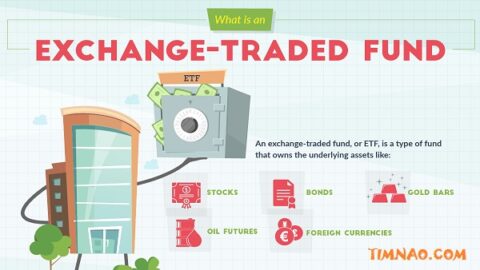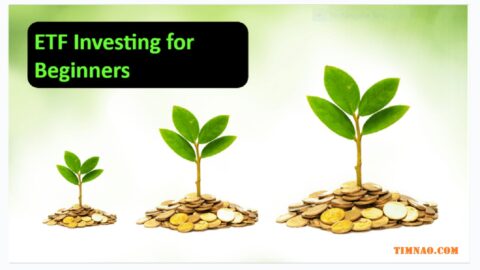An Ultimate Guide to Investing for Beginners: The Astonishing Secret to Building Long-Term Wealth 🚀
This guide is your first step toward understanding investing for beginners. The world of finance can often feel like an exclusive club, filled with confusing jargon and intimidating charts. But the astonishing secret is that the core principles of building wealth are accessible to everyone. You don’t need a fancy degree or a massive income to get started; you just need a clear plan and the discipline to follow it.
This article will demystify the process, showing you exactly how to start investing and create a secure financial future. We’ll break down everything from setting a budget and understanding your spending habits to choosing your first investments and designing a portfolio that grows with you. Our goal is to empower you with the knowledge and confidence to take control of your money and begin your journey to build long-term wealth.
Table of Contents
- Part 1: The Foundation: Mastering Your Money Before You Invest 🏛️
- Why Your Relationship with Money is the First Hurdle
- The Essential First Step: Crafting a Budget That Actually Works
- Building Your Financial Safety Net: The Non-Negotiables
- The Magic of Automation: Put Your Financial Progress on Autopilot
- Part 2: The Gateway to Growth: Your First Steps into the World of Investing 🌱
- What is Investing, and Why Isn’t It Just for the Wealthy?
- The Big Three: A Simple Guide to Stocks, Bonds, and Real Estate
- Finding Your Investor Identity: How Much Risk Can You Handle?
- Part 3: Building Your Investment Engine: Practical Strategies for Beginners ⚙️
- The Easiest On-Ramp: A Beginner’s Guide to Index Funds and ETFs
- Beyond the Basics: A Glimpse into Choosing Individual Stocks
- Building a Portfolio Without a Fortune: Exploring Modern Real Estate Investing
- The Modern Portfolio: What About Cryptocurrency and Alternatives?
- Exploring the Frontier: A Glimpse into Advanced Investing Methods
- Part 4: The Long Game: Lifelong Strategies to Build and Protect Your Wealth ♟️
- The Blueprint for Success: How to Design a Diversified Portfolio
- Staying on Course: The Critical Importance of Rebalancing
- The Ultimate Goal: Calculating Your Financial Freedom Number
- Investing Through the Ages: How Your Strategy Should Evolve
- Conclusion: Your Journey to Financial Freedom Starts Now ✨
Part 1: The Foundation: Mastering Your Money Before You Invest 🏛️
Before you can successfully build wealth through investing, you must first build a solid financial foundation. Think of it like constructing a house; you wouldn’t put up walls and a roof on shaky ground. Investing works the same way. Pouring money into the stock market without first mastering your personal finances is a recipe for stress and potential disaster.
This foundational stage is all about understanding your relationship with money, controlling where it goes, and creating a safety net that protects you from life’s unexpected turns. By mastering these basics, you set yourself up for sustainable, long-term success.
When people hear the word “investing,” it often brings to mind fast-moving stock tickers, Wall Street jargon, or needing large amounts of cash to get started. But here’s the truth: anyone can invest, even with as little as $10 a week.
Investing for beginners is simply the act of putting your money to work so it grows over time. Instead of letting your savings sit idle in a regular bank account, you can use investing to generate returns through avenues like:
-
Stocks
-
Bonds
-
ETFs (Exchange Traded Funds)
-
Real estate
-
Index funds
- Crypto
A crucial concept is compound interest—where the interest your money earns also starts earning interest. The earlier you start, the more time your investments have to grow exponentially.
In short: investing isn’t a luxury. It’s a necessity for long-term financial freedom.
Why Your Relationship with Money is the First Hurdle
Your journey begins not with numbers, but with your mindset. How do you view money? Is it a source of anxiety and stress, or is it a tool that can help you build the life you desire? Many of us develop emotional triggers around spending, often shopping to relieve stress or celebrating achievements with purchases we may not need. This is where many financial plans fail before they even start.
Recognizing these patterns is the first step toward change. Acknowledge that your spending is often driven by emotions, not just logic. The goal isn’t to feel guilty about past mistakes but to become a more mindful consumer. By understanding the “why” behind your spending, you can shift from being a passive participant in your financial life to an active, empowered architect of your future.
Wealth begins in the mind.
The biggest barriers to investing aren’t usually financial—they’re emotional and psychological:
Common psychological blocks:
-
“I don’t know enough.”
-
“I’m afraid of losing money.”
-
“I’ll wait until I earn more.”
Instead, shift your mindset:
-
See money as a tool, not a source of stress.
-
Embrace delayed gratification over instant pleasure.
-
Avoid social comparison—don’t invest based on what others are doing.
Investing isn’t a race. It’s a personal journey. Be patient, consistent, and strategic.
The Essential First Step: Crafting a Budget That Actually Works
The word “budget” often makes people cringe, imagining a restrictive plan that sucks all the fun out of life. In reality, a budget is a tool for empowerment. It’s a simple plan that tells your money where to go, ensuring you’re covering your needs, enjoying your life, and still making progress toward your goals.
For beginners, a great starting point is the 50/30/20 rule. It’s simple: allocate 50% of your after-tax income to “Needs” (rent, groceries, utilities), 30% to “Wants” (dining out, hobbies, streaming services), and 20% to “Savings & Debt Repayment.” This framework provides a clear, balanced approach to managing your money without tedious tracking of every single penny.
If you prefer more control, zero-based budgeting might be for you. With this method, you assign a job to every single dollar you earn, ensuring that your income minus your expenses equals zero. Modern budgeting apps have made this easier than ever. While Mint is no longer with us, powerful tools like YNAB (You Need A Budget) or Monarch Money can sync with your accounts and make managing your finances intuitive and even enjoyable.
Building Your Financial Safety Net: The Non-Negotiables
Before you invest a single dollar, two things are non-negotiable: an emergency fund and a plan to tackle high-interest debt. These elements form the bedrock of your financial security, acting as a crucial buffer against the unexpected.
First, your emergency fund. This is a stash of cash, separate from your checking account, designed to cover 3-6 months of essential living expenses. If you lose your job or face a medical emergency, this fund will be your lifeline, preventing you from derailing your financial progress or going into debt. Start by saving a small amount, perhaps $1,000, and then continue building it until you reach your 3-6 month goal.
Second, you must aggressively pay down high-interest debt. This primarily means credit card debt, which often carries interest rates of 20% or higher. Paying off a credit card with a 22% APR is equivalent to getting a guaranteed 22% return on your money—a return you simply won’t find anywhere else. Use methods like the “debt snowball” (paying off smallest balances first for psychological wins) or the “debt avalanche” (paying off highest interest rates first to save the most money) to get started.
Don’t invest without a goal.
Ask yourself: Why are you investing?
-
Is it to retire early?
-
Buy a home?
-
Create passive income?
-
Fund your children’s education?
Write down your short-term (1–3 years), mid-term (3–7 years), and long-term (10+ years) goals. These goals will determine:
-
How much risk you can take
-
What investment types to choose
-
Your ideal time horizon
Without a goal, your investing will feel like shooting darts in the dark.
The Magic of Automation: Put Your Financial Progress on Autopilot
The secret to consistency in personal finance is to remove yourself from the equation as much as possible. Willpower is a finite resource, but automated systems run 24/7. This is the simplest yet most powerful hack to ensure you’re always making progress.
Set up automatic transfers from your checking account to your savings and investment accounts every payday. This “pay yourself first” strategy ensures that your financial goals are prioritized before you have a chance to spend the money elsewhere. You can also automate your bill payments to avoid late fees and protect your credit score. By setting up these systems once, you create a powerful, silent engine that continuously works to build long-term wealth in the background.
Automate and Optimize: Investing on Autopilot
Automation is your best friend when it comes to building wealth effortlessly.
Here’s what you can automate:
-
Automatic transfers to your investment accounts (e.g., $200/month to Roth IRA)
-
Bill payments to avoid fees
-
Debt payments with the snowball or avalanche method
-
Dividend reinvestment to grow your portfolio faster (via DRIPs)
Robo-advisors like Betterment or SoFi Invest are also great for beginners who want professional help without high fees.
Set it and forget it—but review your progress quarterly.
Part 2: The Gateway to Growth: Your First Steps into the World of Investing 🌱
Once your financial foundation is secure—you have a budget, an emergency fund, and a handle on your debt—you’re ready to step into the world of investing. This is where your money starts working for you, growing and compounding over time to create a future of financial freedom.
Many beginners are intimidated by investing, but it doesn’t have to be complicated. In this section, we’ll strip away the jargon and focus on the core principles you need to know to get started with confidence.
What is Investing, and Why Isn’t It Just for the Wealthy?
At its core, investing is the process of using your money to buy assets that have the potential to generate a return. An asset can be a small piece of a company (a stock), a loan to a government or corporation (a bond), or a physical property (real estate). The goal is for these assets to increase in value over time or pay you income, or both.
The single most powerful force in investing is compound interest. This is when your investment returns start earning their own returns, creating a snowball effect that can lead to exponential growth. For example, if you invest $10,000 and earn a 7% annual return, you’ll have $10,700 after one year. The next year, you’ll earn 7% on the full $10,700, not just the original $10,000. Over decades, this effect becomes incredibly powerful, which is why starting early is the greatest advantage an investor can have.
The Big Three: A Simple Guide to Stocks, Bonds, and Real Estate
For beginners, it’s best to start with the three main types of investments. Understanding them is a key part of learning how to start investing.
- Stocks (Equities): When you buy a stock, you are buying a small share of ownership in a public company like Apple or Amazon. If the company does well, the value of your share can go up, and the company might pay you a portion of its profits, called a dividend. Stocks have historically provided the highest returns over the long term, but they also come with higher risk and volatility.
- Bonds (Fixed Income): When you buy a bond, you are essentially lending money to a government or a corporation. In return, they promise to pay you periodic interest payments over a set term and then return your original investment, the “principal,” at the end. Bonds are generally safer and less volatile than stocks, making them a good tool for balancing risk in a portfolio.
- Real Estate: This is an investment in physical property. You can invest directly by buying a house or apartment to rent out, or you can invest indirectly through Real Estate Investment Trusts (REITs), which are companies that own and manage a portfolio of properties. Real estate can provide a steady cash flow from rent and has the potential to appreciate in value over time.
Finding Your Investor Identity: How Much Risk Can You Handle?
Before you invest, you need to understand your risk tolerance. This is your personal comfort level with the idea that your investments could lose value. It’s influenced by factors like your age, financial goals, and emotional resilience. Are you someone who would panic and sell if the market dropped 20%, or would you see it as a buying opportunity?
A younger investor with decades until retirement can typically afford to take on more risk (i.e., hold more stocks) because they have plenty of time to recover from market downturns. Someone nearing retirement, however, will likely have a lower risk tolerance and will want to focus more on preserving their wealth with safer assets like bonds. Being honest with yourself about your risk tolerance is crucial for building a portfolio that you can stick with through good times and bad.
Part 3: Building Your Investment Engine: Practical Strategies for Beginners ⚙️
With a solid understanding of the basics, it’s time to put your knowledge into action. This section focuses on the practical steps and strategies you can use to start building your investment portfolio. We’ll cover the most accessible entry points for beginners and explore how to create a diversified engine for long-term growth.
The Easiest On-Ramp: A Beginner’s Guide to Index Funds and ETFs
For the vast majority of people starting their journey in investing for beginners, the best place to start is with index funds and Exchange-Traded Funds (ETFs). These are fantastic tools that remove the pressure of having to pick individual winning stocks.
An index fund is a type of mutual fund that holds all the stocks in a particular market index, like the S&P 500 (the 500 largest companies in the U.S.). Because the fund simply aims to match the performance of the market, it’s known as a “passive” investment. This makes them incredibly low-cost and provides instant diversification.
An ETF is very similar but trades on the stock exchange just like an individual stock, making it easy to buy and sell throughout the day. For beginners, popular low-cost ETFs like the Vanguard Total Stock Market ETF (VTI) or the iShares Core S&P 500 ETF (IVV) are excellent choices. By buying a single share of one of these, you instantly own a tiny piece of hundreds or thousands of companies, effectively spreading your risk across the entire market.
Beyond the Basics: A Glimpse into Choosing Individual Stocks
Once you’re comfortable with index funds, you might become curious about buying shares in individual companies. While this can be rewarding, it requires more research and carries more risk. The two most common strategies are growth investing and value investing.
Growth investing focuses on companies that are expected to grow faster than the overall market. These are often innovative tech companies that reinvest all their profits back into the business to fuel expansion, rather than paying dividends. Value investing, popularized by Warren Buffett, is the art of finding great companies that are temporarily undervalued by the market, buying them at a discount, and holding them until their true worth is recognized. Both strategies require you to research a company’s financial health, management team, and competitive position.
Building a Portfolio Without a Fortune: Exploring Modern Real Estate Investing
The idea of buying an investment property can seem out of reach for many beginners. However, technology has made real estate investing more accessible than ever, even with small amounts of capital.
Real Estate Investment Trusts (REITs) are a great starting point. As mentioned earlier, these are companies you can invest in on the stock market that own and operate income-producing real estate. You get the benefits of rental income (paid out as dividends) and property appreciation without the hassle of being a landlord.
Another powerful option is real estate crowdfunding. Platforms like Fundrise and RealtyMogul allow you to pool your money with other investors to invest in large-scale residential or commercial properties. This allows you to diversify into real estate with as little as a few hundred dollars, making it a revolutionary way for beginners to access this asset class.
Building Your First Portfolio: How to Start Small and Grow
1. Understand the Asset Classes
Here are the core building blocks of any investment portfolio:
-
Stocks: Ownership in companies. High risk, high return.
-
Bonds: Loans to governments or corporations. Lower risk, stable returns.
-
ETFs & Index Funds: Diversified, low-cost ways to invest in large sections of the market.
-
Real Estate: Tangible assets, good for long-term appreciation and rental income.
2. Determine Your Risk Tolerance
Ask:
-
Can I handle seeing my portfolio drop 20% in a bad year?
-
How long before I’ll need this money?
Use tools like Vanguard’s Investor Questionnaire to figure out your comfort level with risk.
3. Start with a Simple Portfolio
A common beginner’s allocation:
-
60% in a diversified ETF (like VTI or SPY)
-
30% in bonds or a bond ETF
-
10% in a high-yield savings or cash reserve
Use platforms like Fidelity, Robinhood, or Wealthfront to get started.
The Modern Portfolio: What About Cryptocurrency and Alternatives?
In today’s world, it’s impossible to discuss investing without mentioning cryptocurrencies like Bitcoin and Ethereum. While they offer the potential for massive returns, they are also incredibly volatile and speculative assets. They are not backed by any physical assets or cash flow, and their value is driven largely by market sentiment and adoption.
For a beginner, it’s wise to be extremely cautious. A prudent approach is to consider crypto an “alternative” investment and allocate a very small portion of your portfolio to it—no more than 1-5%, and only with money you are fully prepared to lose. Your core portfolio should be built on time-tested assets like stocks, bonds, and real estate.
Exploring the Frontier: A Glimpse into Advanced Investing Methods
As you become more comfortable with the fundamentals, it’s helpful to be aware of the more advanced strategies that are shaping the future of investing. While the methods below are generally not starting points for beginners, understanding them will prepare you for the next steps in your financial journey.
1. Direct Indexing: Think of this as a DIY index fund. Instead of buying a single ETF, you directly own the dozens or hundreds of individual stocks that make up an index. This was once only for the ultra-wealthy, but technology is making it more accessible. Its main advantage is greater control for tax optimization and personalizing your portfolio (e.g., removing companies you don’t support), but it requires a higher minimum investment and is more complex than simply buying an ETF.
- How it’s “Latest”: Previously available only to institutional and high-net-worth investors, technology has made direct indexing accessible to retail investors through major brokerage platforms.
- Benefits: It offers greater personalization. You can exclude specific stocks or sectors that don’t align with your values (e.g., fossil fuels, tobacco) and optimize for taxes by selling individual losing stocks to offset gains (tax-loss harvesting), a feature not possible with a single ETF.
- Risks: It typically requires a higher minimum investment than an ETF and can be more complex to manage.
2. Fractional Investment in Alternative Assets: Have you ever wanted to own a Picasso or a rare vintage car? Fractional investing makes this possible by allowing you to buy a small “share” of a high-value collectible. This can provide diversification away from the stock market, but these assets are often illiquid (hard to sell) and their value can be subjective, making them a higher-risk endeavor.
- How it’s “Latest”: This trend has matured, with established platforms now offering a wider range of assets beyond real estate.
- Examples:
- Why Your Relationship with Money is the First Hurdle
– Fine Art: Buying a fraction of a painting by a renowned artist.
– Rare Collectibles: Investing in shares of vintage cars, luxury watches, or rare comic books.
– Private Credit: Participating in loans made to established private businesses.
- Benefits: Allows for diversification into assets that are not correlated with the stock market.
- Risks: These assets are highly illiquid (hard to sell quickly), and their valuation can be subjective. This is generally for investors with a higher risk tolerance.
3. Advanced Thematic and Sector-Specific ETFs: Beyond broad market ETFs, there are hyper-focused funds for niche, futuristic trends like space exploration, genetic editing, or AI infrastructure. While these offer a chance to invest in high-growth industries, they are far less diversified and much more volatile than a standard S&P 500 ETF. Consider them speculative “satellite” holdings for a tiny portion of your portfolio, not the core.
- How it’s “Latest”: The specificity and variety of these funds have exploded, allowing investors to make targeted bets on emerging trends.
- Examples of 2025 Themes:
- AI Infrastructure: Funds focusing not just on AI software companies, but on the businesses building the underlying infrastructure, like data centers, specialized semiconductors, and cooling technologies.
- Space Exploration & Commercialization: ETFs that invest in satellite companies, launch providers, and businesses enabling commercial activity in space.
- Longevity and Genetic Editing: Funds targeting companies at the forefront of anti-aging research, gene-editing technologies (like CRISPR), and advanced medical treatments.
- Benefits: Provides access to high-growth potential industries.
- Risks: These funds are less diversified than broad market indexes and can be highly volatile. They are considered speculative satellite holdings rather than core investments.
4. AI-Driven Portfolio Management: This is the next evolution of robo-advisors. Instead of just setting a portfolio based on a questionnaire, these platforms use artificial intelligence to make dynamic adjustments based on market trends and economic data. They offer a high level of sophistication, but you must be comfortable trusting an algorithm with your investment decisions.
- How it’s “Latest”: The integration of generative AI and predictive analytics is making these platforms more powerful than the first-wave robo-advisors.
- Advanced Features:
- Dynamic Rebalancing: AI algorithms adjust portfolio allocations in real-time based on market indicators and economic forecasts, rather than just on a fixed schedule.
- Personalized Advice: AI can analyze an investor’s complete financial picture (spending habits, income, stated goals) to provide more tailored and proactive investment suggestions.
- Benefits: Offers a higher level of sophistication and personalization in automated investing.
- Risks: The strategies are based on algorithms that may not perform as expected in unprecedented market conditions.
5. Tokenization of Real-World Assets (RWAs): This is a cutting-edge evolution of fractional investing that uses the blockchain technology behind cryptocurrency. It converts ownership rights of a physical asset, like a commercial building, into a digital “token” that can be easily traded. While it promises to make illiquid assets more accessible, the technology is very new and the regulatory landscape is still developing, making it a high-risk area for now.
- How it’s “Latest”: The technology and regulatory frameworks are rapidly developing in 2024 and 2025, making this a cutting-edge investment area.
- How it Works: Instead of a legal deed, ownership in an asset (like a commercial building or a portfolio of private loans) is represented by a digital token.
- Benefits: It aims to bring liquidity to traditionally illiquid assets, like real estate or private equity, and make them easily divisible and tradable 24/7.
Risks: The technology is new, the regulatory environment is still uncertain, and it carries cybersecurity risks.
Part 4: The Long Game: Lifelong Strategies to Build and Protect Your Wealth ♟️
Investing isn’t a one-time event; it’s a lifelong journey. As you progress in your career and move through different life stages, your financial goals and strategies will need to evolve. This final section covers the long-term principles that will help you manage, grow, and protect your wealth for decades to come.
The Blueprint for Success: How to Design a Diversified Portfolio
The cornerstone of a solid investment strategy is diversification. The old saying “don’t put all your eggs in one basket” is the most important rule in investing. By spreading your money across different asset classes (stocks, bonds, real estate), geographic regions (U.S., international), and industries (tech, healthcare, consumer goods), you reduce your overall risk.
When one part of your portfolio is performing poorly, another part may be doing well, smoothing out your overall returns. For a beginner, a simple diversified portfolio might consist of a U.S. total stock market ETF, an international stock market ETF, and a total bond market ETF. This simple three-fund portfolio provides broad, global diversification at a very low cost.
Staying on Course: The Critical Importance of Rebalancing
Over time, as your investments grow at different rates, your portfolio’s original allocation will drift. For example, if stocks have a great year, they might grow from 60% of your portfolio to 70%. This means you are now taking on more risk than you originally intended.
Rebalancing is the process of periodically selling some of your outperforming assets and buying more of your underperforming assets to return to your target allocation. This disciplined approach forces you to “sell high and buy low” and ensures that your portfolio’s risk level remains aligned with your comfort level. You can do this on a set schedule, like once a year, or whenever your allocation drifts by a certain percentage (e.g., 5%).
The Ultimate Goal: Calculating Your Financial Freedom Number
To make your journey tangible, you need a target. This is your “financial freedom number”—the amount of money you need invested to live off the returns indefinitely without having to work. A widely used guideline for this is the 4% rule.
The rule suggests that you can safely withdraw 4% of your total investment portfolio each year in retirement without running out of money. To calculate your number, simply multiply your desired annual income by 25. For example, if you want to live on $60,000 per year, your financial freedom number would be $1.5 million ($60,000 x 25). This target gives you a clear goal to work toward and helps you track your progress along the way.
Investing Through the Ages: How Your Strategy Should Evolve
Your investment strategy should not be static. In your 20s and 30s, your focus should be on aggressive growth. With decades ahead of you, you can have a portfolio heavily weighted in stocks (perhaps 80-90%) to maximize the power of compounding.
As you move into your 40s and 50s, your focus will gradually shift from pure growth to a balance of growth and preservation. You might start reducing your stock allocation and adding more bonds to lower your portfolio’s volatility. This is also the time to take advantage of “catch-up” contributions, which allow you to put extra money into your retirement accounts. For 2025, those 50 and over can contribute an extra $8,000 to their 401(k) and an extra $1,000 to their IRA.
In your 60s and beyond, your primary goal becomes wealth preservation and generating income. Your portfolio will be much more conservative, with a larger allocation to bonds and dividend-paying stocks to provide a steady income stream to fund your retirement.
Conclusion: Your Journey to Financial Freedom Starts Now ✨
You have now journeyed through the essential landscape of investing for beginners, from building your financial foundation to crafting a lifelong strategy to build long-term wealth. The path forward is about turning this knowledge into action. The most successful investors share three key habits: the discipline to stick to their plan, the patience to let compounding work its magic, and a commitment to continuous learning.
Long-Term Success: Stay Consistent, Stay Ahead
Golden Rules for Long-Term Investing Success:
-
Stay the course. Markets will go up and down—your job is to stay in the game.
-
Rebalance your portfolio once or twice a year to maintain your target allocation.
-
Avoid emotional decisions. Don’t panic-sell during downturns.
-
Continue learning. Follow blogs like NerdWallet, Investopedia, and Morningstar.
Future-Proof Your Portfolio:
-
Add international funds for geographic diversification.
-
Consider ESG (Environmental, Social, Governance) investing if values matter to you.
-
Explore REITs, crypto, or thematic funds once you’re comfortable with the basics.
The single greatest investment you can make is in yourself—in your knowledge, your skills, and your well-being. By embracing this journey, you are not just building a portfolio; you are designing a life of freedom, security, and choice. The power to transform your financial future is in your hands. Start today.
Reference video:









